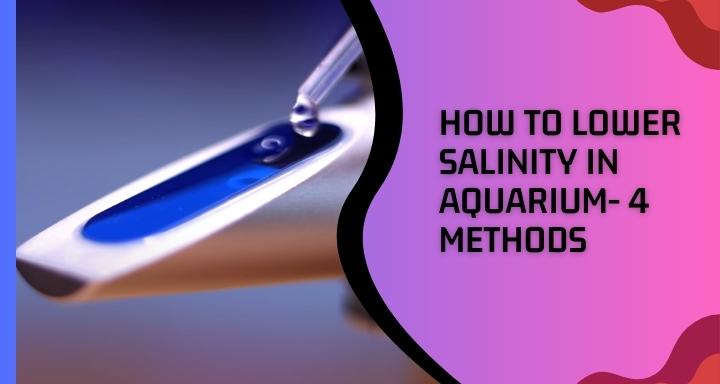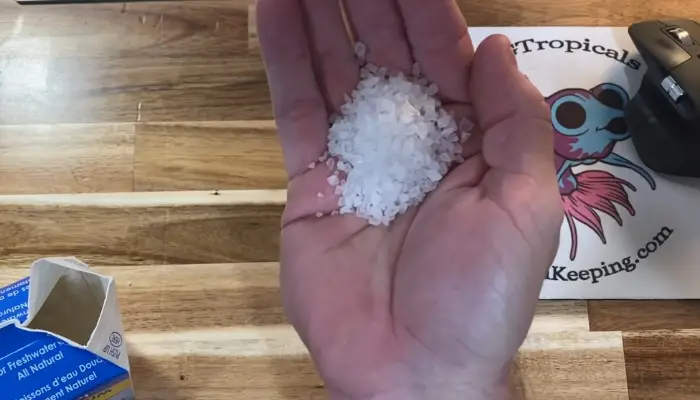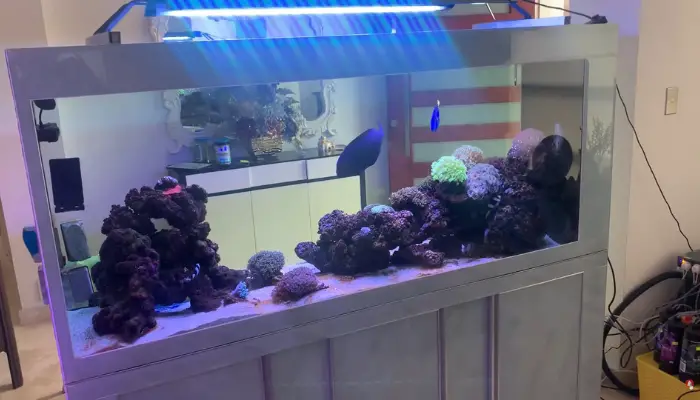
If you ask me how to get rid of excess salinity in an aquarium, I can suggest four methods. These are- partial water changing, removing saltwater decorations, adjusting the salt level, and monitoring the water parameters.
Whenever people ask me about this fact, I mention these ways so that they can check the problem. From that view, I thought why not help my online friends about it too? This is why, I have decorated this article for those hobbyists who are suffering from increased salt level problems.
Meanwhile, I have mentioned the ways. But if you are interested in the detailed information about those methods, scroll below and enjoy the information.
4 Easy Methods of Lowering the Salt Level in an Aquarium

1. Perform a Partial Water Change
The first point I always try to adapt in reducing the salt level in an aquarium is partial water changes.
This involves replacing a portion of the aquarium water with fresh and dechlorinated water. Look how I do this step by step.
Test the Water
Before you start, use a saltwater test kit to check the current salt level in your aquarium. This will give you an idea of how much water needs to be changed.
Prepare the Freshwater
Fill a clean bucket with fresh water that has been treated with a dechlorinating agent. Make sure the temperature and salinity of the freshwater match that of the aquarium water.
Remove Water
Using a siphon or a gravel vacuum, remove about 10-15% of the water from your aquarium. Be careful not to disturb the gravel or any decorations in the aquarium.
Add Fresh Water
Slowly pour the fresh water into the aquarium. It’s best to pour the water onto a plate or saucer placed at the bottom of the aquarium to prevent disturbing the substrate.
Mix the Water
Allow the fresh water to mix with the remaining aquarium water for at least 15-20 minutes before testing the salinity again. If the salt level is still too high, repeat the process until you achieve the desired level.
It’s important to note that you should never change more than 25% of the aquarium water at a time, as this can shock the fish and disrupt the aquarium’s delicate ecosystem.
2. Remove Saltwater Decorations
Next, I will suggest you remove saltwater decorations from your aquarium if you possess anyone. Saltwater decorations are decorative items that are specifically designed for use in saltwater aquariums.
These decorations can be made from various materials, including live rocks, coral, artificial rocks, driftwood, and synthetic materials. Such types of materials may also add extra salt to your aquarium water.
That’s why if your aquarium contains saltwater decorations or substrates, it is necessary to remove them. At the same time, rinse them thoroughly with fresh water to remove any salt residue.
3. Adjust the Salinity Level
If the salt level is still too high after a partial water change, you may need to adjust it with other techniques. Sometimes I also need to do so. Here are the steps that I follow in the case of any aquarium-
Measure the Salinity Level
Use a hydrometer or a refractometer to measure the salinity level of the aquarium water. The salinity level is usually measured in specific gravity or parts per thousand (ppt).
Determine the Desired Salinity Level
Different types of fish and aquatic organisms have different salinity requirements. Consult with a professional or research the specific salinity requirements for the species in your aquarium.
Adjust the Salinity Level
Add fresh water gradually over a period to lower the salinity level to the desired level. Thus, you can adjust the salinity level in your aquarium.
4. Monitor the Water Parameters
As you know, monitoring the underlying causes of high salinity can inform strategies for lowering it. That’s why I want to mention some key water parameters that can help you in this regard.
Conductivity
Conductivity is a measure of the ability of water to conduct electricity, which is directly related to the amount of dissolved salts in the water. By monitoring conductivity, you can track changes in salinity over time. If conductivity levels are too high, adding freshwater can dilute the salt concentration and lower salinity.
pH
The pH of water can affect the solubility of salts and minerals, which can impact salinity levels. If the pH of water is too high or too low, it can cause salts to precipitate out of the solution, which can reduce salinity levels. However, it’s important to note that adjusting pH levels can also affect other water parameters and may require careful monitoring.
Total Dissolved Solids (TDS)
TDS measures the total amount of dissolved solids in water, including salts, minerals, and other substances. Monitoring TDS levels can help you track changes in salinity and identify potential sources of salt contamination. If TDS levels are too high, you may need to consider filtration or desalination techniques to remove salt from the water.
Nitrate and Phosphate Levels
High levels of nitrate and phosphate can contribute to the growth of algae, which can lead to increased salinity through evaporation. Monitoring and controlling these nutrients can help prevent excess algae growth and lower salinity levels.
Temperature
High temperatures can increase the rate of evaporation, which can cause salt concentrations to increase. If you’re trying to lower salinity, keeping water temperatures cooler may help reduce evaporation rates and slow the increase in salt concentration
Effects of High Salinity in an Aquarium
If I want to list down the effects of salinity I have to mention their stress condition first. As you know, fish and other aquatic organisms are adapted to specific levels of salinity in their natural habitats. But, high salinity levels in an aquarium can cause stress. As a result, it can weaken the immune system and make fish more susceptible to disease.
Moreover, high salinity levels can cause fish to lose water through osmosis. As a result, they become prone to dehydration. This can cause fish to become lethargic, lose appetite, and become more susceptible to disease.
As a hobbyist, you know that oxygen level is an important issue for the fish. But the amount of dissolved oxygen in the water is reduced if you don’t control the salt level.
Such a situation makes the atmosphere difficult for fish and other aquatic organisms to breathe. This can cause fish to become stressed, lethargic, and even die if oxygen levels drop too low.
Also, increased salinity levels may cause internal damage to the fish. It can damage the delicate gill tissues of fish and other aquatic organisms, making it difficult for them to breathe. Thus your fish become stressed and more susceptible to disease.
Not only fish but also plant damage are also caused by high salinity. Due to excessive salinity, the leaves and roots of plants in the aquarium become wilted and may die. This can upset the balance of the ecosystem in the aquarium and lead to further aquatic problems.
Signs of High Salinity in an Aquarium

Dying Corals and Invertebrates
High salinity levels can be detrimental to corals and invertebrates in the aquarium. If you notice that they are dying or not thriving as they should be, it could be a sign of high salinity.
Fish Behavior Changes
If your fish are behaving abnormally, such as gasping for air at the surface of the water or swimming erratically, it could be due to high salinity levels. In extreme cases, high salinity can even lead to fish death.
Algae Growth
High salinity levels can also promote the growth of algae in the aquarium. If you notice an excessive amount of algae growth, it may be a sign of high salinity.
Cloudy Water
If your aquarium water appears cloudy or murky, it could be due to high salinity levels. This could be caused by dissolved minerals and other compounds in the water that are not being properly filtered out.
High Salt Readings
Finally, the most obvious sign of high salinity is a high salt reading on your aquarium water test kit. If you regularly test your water and notice that the salt levels are consistently higher than they should be, it could be a sign that you need to take action to lower the salinity
What Causes Excess Salinity in an Aquarium
Along with the effects and signs, the causes behind salinity increase are also important knowledge. If you don’t know the causes of salt level enhancement, your aquarium will get back to the same stage of salinity despite maintaining the upper mentioned methods. Hence, focus on the below-mentioned reasons.
Lack of Water Changes
The first reason behind increasing salt levels can be your avoidance of water changing facts. If you fail to perform regular water changes, it can cause the concentration of salt in the aquarium to increase over time.
Evaporation
You know, evaporation is a common term for aquariums. When water evaporates from the aquarium, the present salt concentration becomes more concentrated. As a result, the same level of salt results in an increase in salinity in the aquarium water and causes problems for your fish and other inhabitants.
Inadequate Filtration
As you know, cleansing is an important factor in a healthy aquarium atmosphere. However, a lack of adequate filtration can cause waste and excess food to accumulate in the aquarium. After that, you can easily understand that the salinity level is increasing.
Overfeeding
Don’t you believe that? But yeah! Overfeeding your fish can also cause salinity to increase. In this case, excess food particles sink to the bottom of the aquarium and decompose. Such types of decomposition can lead to an increase in salinity levels.
Use of Saltwater Mix
Though this reason completely depends on you, still I want to mention some words about it. In the case of using a saltwater mix to create the water in your aquarium, it can cause the salinity to rise. But how?
Adding too much salt or failing to properly mix the saltwater solution can cause this problem. That’s why before doing such a mixture, you should be careful about the salt level in your aquarium.
How Fast Can I Lower Salinity
The rate at which you can lower salinity in an aquarium depends on several factors. Those factors include the current salinity level, the volume of the aquarium, the type of filtration system you are using, and the type of livestock in the aquarium.
Lowering salinity too quickly can be harmful to your aquatic animals. Hence, it’s important to take a gradual approach. As a general rule, it’s recommended to lower salinity by no more than 0.002-0.003 points per day, which translates to a maximum of around 1-2% per day.
If I want to provide a safe suggestion, I can recommend using a hydrometer or refractometer. It’s important to monitor the salinity level frequently to ensure that it’s decreasing at a safe rate by using that equipment.
Else, if you face problems in reducing calcium or phosphate levels in your aquarium or reef tank along with salinity, you can have a look at my previous contents mentioned here.
- How to Lower Calcium in Reef Tanks and Freshwater Aquariums
- How to Reduce Phosphates in Reef Tank and Aquarium – 7 Ways
How to Lower Salinity in a Marine Aquarium
Partial Water Changes
One of the easiest and most effective ways to lower salinity is by performing partial water changes. You can remove some of the water from your aquarium and replace it with fresh water. This will dilute the salt concentration and lower the salinity.
Reverse Osmosis (RO) Water
You can also use RO water to dilute the saltwater in your aquarium. RO water is free of dissolved solids, so it can help to lower the salinity of your aquarium water. You can purchase an RO unit or RO water from a local fish store.
Use Salt Mix with Lower Salinity
If you are mixing your saltwater, you can use a salt mix with a lower salinity level. There are many different types of salt mixes available, so you can choose one that matches the desired salinity level for your aquarium.
Adding Freshwater
You can also add fresh water directly to your aquarium to lower the salinity. This method is best used when making small adjustments to the salinity level, as adding too much freshwater at once can shock your aquarium’s inhabitants.
If you want a vast idea about the marine aquarium, I can suggest it to you in my next entry. So, inform me about this fact.
How Can I Test the Salinity Level in the Aquarium
To test the salinity level in an aquarium, you will need a salinity test kit. There are several types of salinity test kits available in the market, but the most commonly used one is a hydrometer.
I also use the same test kit for my aquarium. To test by using a hydrometer is an easy task that you will understand after my description. For this purpose, fill a small container with water from your aquarium.
Then, insert the hydrometer into the container, ensuring that it is completely submerged. Next, read the salinity level on the hydrometer’s scale. The salinity is typically measured in specific gravity (SG) or parts per thousand (ppt).
Compare the reading with the desired salinity level for your aquarium inhabitants. The ideal salinity level varies depending on the species of fish and other aquatic organisms in your tank. Generally, saltwater aquariums should maintain a salinity level between 1.020 and 1.025 SG or 30-35 ppt.
It’s important to test the salinity level regularly to ensure that the water conditions in your aquarium remain healthy for your aquatic pets. For your convenience, let me put here a chart about the ideal salinity level in different aquariums.
| Water tank | Ideal salt level |
| Reef tank | Between 1.023 to 1.026 specific gravity, with a target of 1.025 being the most common |
| Saltwater aquarium | Between 1.020 and 1.026 specific gravity |
| Freshwater aquarium | Generally not required. But some fish species may require 1-3 grams per liter of salt |
| Brackish aquarium | 1.005 to 1.015 specific gravity |
| Planted aquarium | Zero |
| Nano aquarium | 1.023-1.025 specific gravity |
| Coldwater aquarium | Generally not required. But some fish species may require 1-3 grams per liter of salt which is 0.1%-0.3% |
FAQs
How often should I perform water changes to maintain the ideal salinity level?
It’s recommended to perform a 10-20% water change every 1-2 weeks to maintain the ideal salinity level in your aquarium. It will be beneficial for your aquarium.
How often should I check the salinity level in my aquarium?
At least once a week. It’s important to check the salinity level in your aquarium regularly. The frequency may need to be increased if you’re experiencing issues with high salinity or if you’ve made changes to your aquarium’s environment.
Can I use chemicals to lower the salinity in my aquarium?
It’s better to avoid chemicals to lower salinity. There are products available that claim to lower the salinity in an aquarium, but they can be harmful to your fish and other inhabitants if not used properly. Hence, I always recommend natural methods.
Final Words
Overall I can say that lowering salinity in water is not too troublesome, but it requires careful monitoring and the implementation of appropriate strategies based on the underlying causes of high salinity.
It’s important to approach salinity management with a holistic understanding of the factors that contribute to it and to regularly test and monitor water quality. Thus, you ensure the salinity levels remain at appropriate levels. Otherwise, the imbalanced salinity level will destroy the ecosystem of your aquarium and the inhabitants will die.
- Top 15 Freshwater Aquarium Plant Ideas for a Lush, Green Tank - November 9, 2024
- Top 13 Freshwater Aquarium Layout Ideas for a Beautifully Organized Tank - November 9, 2024
- 14 Stunning Rustic Freshwater Aquarium Ideas for a Tranquil Environment - November 9, 2024
